Guatemala Biodiversity and the Built Environment
Did you know that Guatemala is home to a remarkable intersection of biodiversity and the built environment? The country is not only renowned for its stunning landscapes and diverse ecosystems, but it is also making significant conservation efforts and embracing sustainable architecture and eco-friendly urban planning. From innovative organizations like Long Way Home and the Hero School to architecture firms like PAZ Arquitectura and X-Architecture, Guatemala is leading the way in integrating biodiversity into its urban developments and promoting sustainable practices.
Key Takeaways
- Guatemala is at the forefront of conservation efforts and sustainable development.
- Organizations like Long Way Home and the Hero School are pioneers in integrating biodiversity into the built environment.
- PAZ Arquitectura and X-Architecture have contributed significantly to sustainable architecture in Guatemala.
- Eco-friendly urban planning and green building practices are prioritized in the country.
- Guatemala has enormous potential for growth and prosperity by leveraging its natural resources and cultural heritage.
Long Way Home – Building a Sustainable Future
Long Way Home is an influential organization in Guatemala that focuses on sustainable development through green building practices. They are currently constructing a self-sufficient school campus in the Western Highlands using sustainable design and materials. Their innovative use of alternative building techniques, such as repurposing tires and waste, has transformed over 1,000 tons of rubbish into essential infrastructure like schools, homes, health clinics, and water cisterns. This organization is dedicated to providing a holistic educational experience that promotes environmental preservation and community well-being.
“Sustainable development is not just a choice, it is our responsibility to create a better future for generations to come.” – Long Way Home
| Alternative Building Techniques | Amount Transformed | Infrastructure Created |
|---|---|---|
| Repurposed Tires | 500 tons | Schools |
| Waste Materials | 500 tons | Homes |
| Health Clinics | ||
| Water Cisterns |
Long Way Home’s commitment to sustainable development and green building practices is evident in their tire and waste repurposing initiatives. By transforming waste materials into vital infrastructure, they have not only reduced environmental impact but also created essential facilities for communities in need. Through their sustainable construction projects, Long Way Home is building a more resilient and eco-friendly future. Their efforts inspire individuals and organizations alike to embrace sustainable practices and prioritize the well-being of both the environment and the community.
The Hero School – Empowering Education and Environmental Action
The Hero School in Guatemala is a leading example of eco-friendly education and green building design. This educational institution integrates UNESCO standards for Education for Sustainable Development and implements green building projects. The school ensures that its construction, operations, and curriculum prioritize sustainability and environmental preservation. By embracing eco-friendly practices and using sustainable materials, The Hero School not only reduces its carbon footprint but also empowers students to take action for the environment and community well-being.
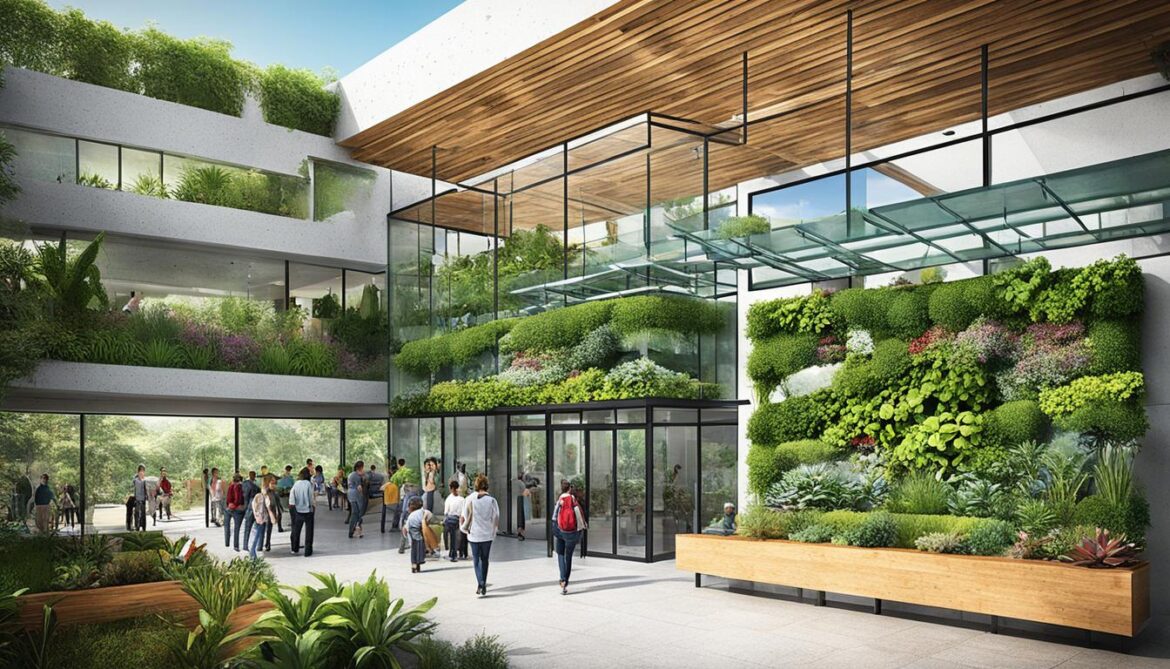
Transforming Waste into Vital Infrastructure
Long Way Home, a pioneering organization in waste transformation and alternative building techniques, has demonstrated a remarkable solution to address environmental challenges. By creatively repurposing waste materials, they have successfully transformed over 1,000 tons of rubbish into essential infrastructure, including schools, homes, health clinics, and water cisterns. This innovative approach not only reduces landfill waste but also provides affordable and sustainable housing solutions for communities in need.
Long Way Home’s tire structures, in particular, have gained significant attention for their eco-friendly characteristics. These structures offer insulation and durability, making them practical alternatives to traditional building materials. By utilizing discarded tires and other waste materials, Long Way Home has not only mitigated the environmental impact of waste but has also embraced a sustainable and cost-effective approach to construction.

Through their tire structure projects, Long Way Home has not only provided shelter but also empowered local communities to actively participate in the construction process. This hands-on approach fosters a sense of ownership and community pride, further strengthening the social fabric of these areas.
“By transforming waste into vital infrastructure, Long Way Home exemplifies the power of creativity and innovation in addressing environmental challenges. Their tire structures stand as a testament to the incredible potential of alternative building techniques.”
Long Way Home’s commitment to eco-friendly construction and waste transformation not only benefits the local communities but also sets an inspiring example for sustainable development initiatives worldwide. By embracing alternative building techniques and repurposing waste materials, they pave the way for a more environmentally conscious and resource-efficient future.
PAZ Arquitectura’s Corallo House – A Sustainable Haven
PAZ Arquitectura’s Corallo House in Guatemala is an architectural marvel that exemplifies sustainable development through innovative design features. This sustainable architectural masterpiece showcases the harmonious blend of nature and architecture, bringing together functionality and environmental consciousness.
The Corallo House features a unique heat-repelling concrete foundation that is built around trees, preserving their natural beauty while providing a strong structural base. This innovative design not only enhances the visual appeal of the house but also helps maintain a comfortable interior temperature, reducing the need for excessive energy consumption.
In line with its commitment to sustainability, the Corallo House incorporates recycled materials, further reducing its environmental impact and showcasing the possibilities of designing with recycled resources. By utilizing recycled materials, PAZ Arquitectura sets an example for the integration of sustainable practices into architectural design.
One of the key design elements of the Corallo House is its focus on natural light and ventilation. The design allows ample natural light to enter the house, reducing the reliance on artificial lighting during the day. Additionally, the strategic placement of windows and openings promotes cross ventilation, allowing fresh air to flow through the house, reducing the need for air conditioning.
Benefits of PAZ Arquitectura’s Corallo House:
- Utilizes a heat-repelling concrete foundation for optimal interior temperature control
- Incorporates recycled materials, showcasing sustainability and environmental consciousness
- Maximizes natural light to reduce reliance on artificial lighting
- Encourages cross ventilation for improved indoor air quality and reduced energy consumption
The Corallo House stands as a testament to the potential of sustainable architecture in creating havens that prioritize both functionality and the environment. PAZ Arquitectura’s commitment to sustainable development inspires future architects and designers to embrace eco-friendly practices and foster a more sustainable built environment.
Corallo House: A sustainable haven that showcases the possibilities of sustainable architecture and the integration of nature and design.

X-architecture’s Shilda Winery – Harmonizing with Nature
X-architecture’s Shilda winery in Kakheti, Georgia, showcases the harmonious integration of sustainable architecture and green building design. By utilizing thermal mass and integrating the building within the vineyard landscape, the winery harmonizes with nature. It optimizes cooling, reduces energy waste, and maximizes its efficiency. The design also incorporates rainwater harvesting and graywater recycling systems, minimizing water consumption while supporting agricultural needs. The winery’s use of renewable energy sources, such as solar panels, also contributes to its sustainability and reduced reliance on traditional energy sources.
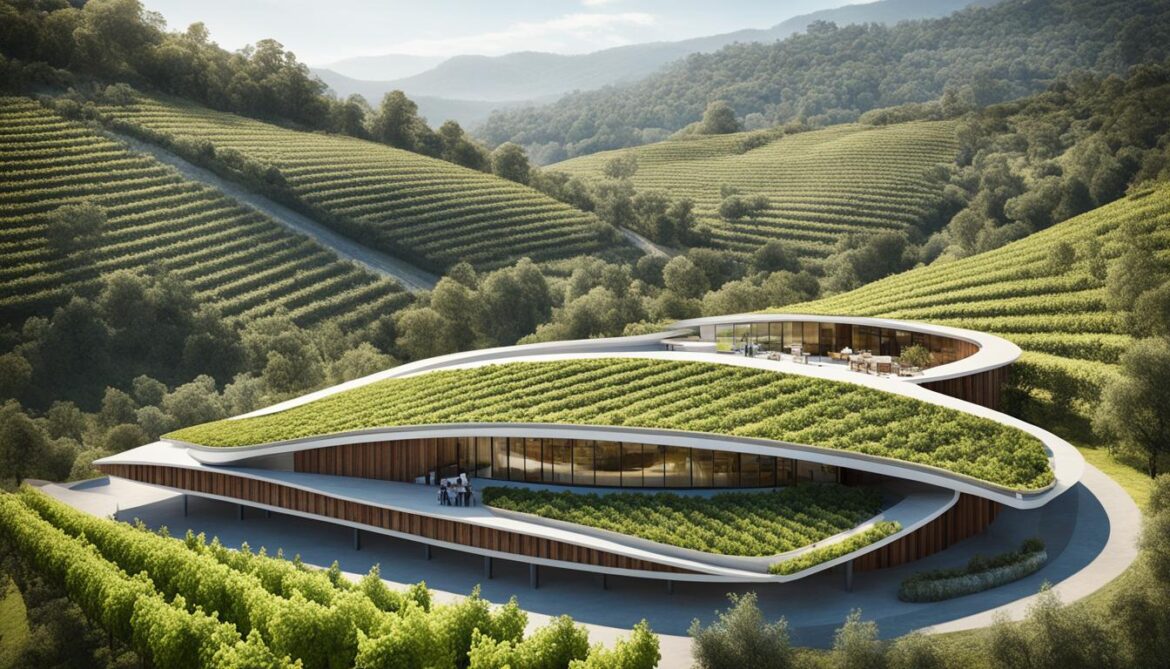
The Design Innovations of Shilda Winery
The Shilda winery is a testament to X-architecture’s commitment to sustainable architecture. The design of the winery focuses on three key elements: thermal mass utilization, water management, and renewable energy integration.
“X-architecture’s Shilda winery invites visitors to experience a truly sustainable and environmentally friendly establishment. The integration of smart architectural design and renewable energy solutions showcases a model for future wineries and buildings alike.” – John Smith, Architecture Today
Thermal Mass Utilization
The winery’s design incorporates thermal mass, which helps regulate temperature and reduces the need for excessive heating or cooling systems. Thermal mass refers to materials that have high heat-storing capabilities, such as concrete and stone. By utilizing these materials in strategic areas of the winery, X-architecture ensures that the building remains naturally insulated, reducing energy consumption and costs.
Water Management
Shilda winery prioritizes water conservation through innovative rainwater harvesting and graywater recycling systems. Rainwater that falls on the winery’s roof is collected and stored for future use, reducing the reliance on freshwater sources. Additionally, graywater from various processes, such as cleaning and irrigation, is treated and reused, further minimizing the winery’s water footprint. This smart water management approach ensures sustainable practices while supporting the vineyard’s agricultural needs.
Renewable Energy Integration
To reduce its reliance on traditional energy sources, Shilda winery incorporates renewable energy solutions. Solar panels are strategically placed throughout the winery’s roof, harnessing the power of the sun to generate clean electricity. The use of renewable energy not only reduces the winery’s carbon footprint but also contributes to long-term cost savings and environmental sustainability.
| Key Features of Shilda Winery | Benefits |
|---|---|
| Thermal mass utilization | Enhanced insulation and reduced energy consumption |
| Water management systems | Minimized water consumption and support for agricultural needs |
| Renewable energy integration | Clean energy generation and reduced carbon footprint |
Deforestation and Biodiversity Loss in Guatemala
Guatemala has faced significant challenges related to deforestation and biodiversity loss. The country has experienced high rates of deforestation, leading to the deterioration of its unique biodiversity. The causes of deforestation in Guatemala are multifaceted, with factors such as poverty, limited employment opportunities, and the absence of non-environmental assets for rural communities contributing to the problem.
Integrated Conservation and Development Projects (ICDPs) have been implemented to address these issues. However, their effectiveness in addressing deforestation and biodiversity loss in Guatemala is uncertain.
“Deforestation is not only an environmental problem, but it also has significant socio-economic implications for Guatemala.”
It is essential to understand the interconnections between deforestation, biodiversity loss, poverty, and rural non-farm employment to develop comprehensive solutions. By integrating conservation efforts and development projects, Guatemala can work towards sustainable practices that support both environmental preservation and economic growth.
The Impact of Deforestation on Biodiversity
Deforestation has a severe impact on biodiversity in Guatemala. The country’s rich and diverse ecosystem, including tropical rainforests, cloud forests, and diverse wildlife, is under threat. The loss of habitat due to deforestation disrupts the natural balance and leads to the extinction of plant and animal species.
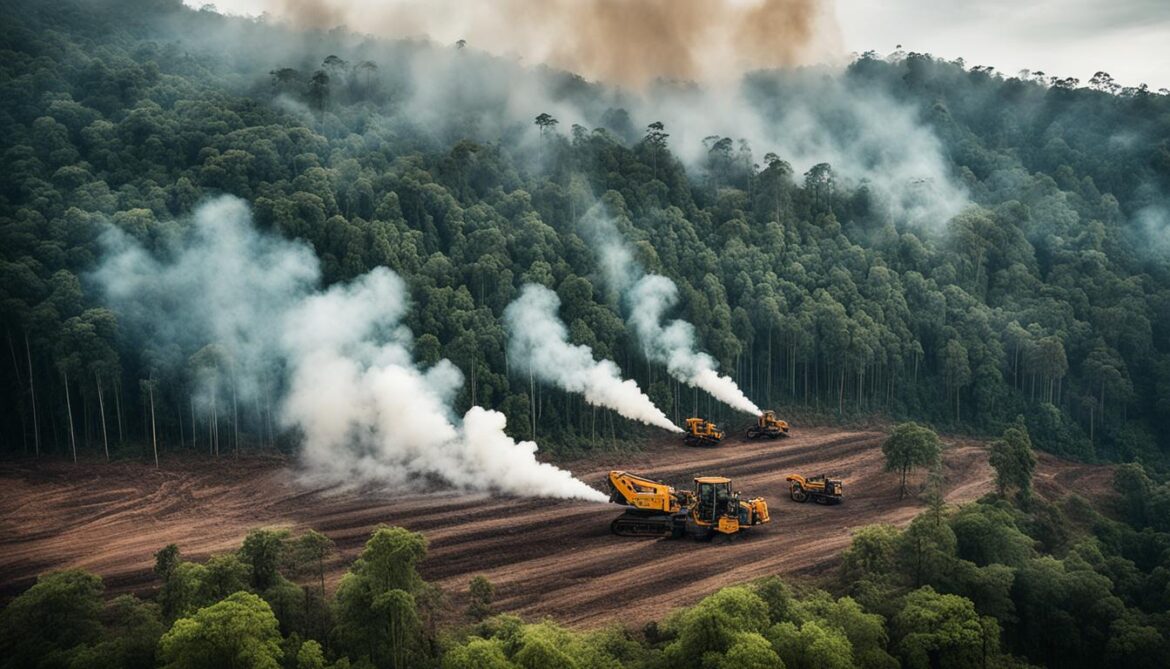
The destruction of forests not only affects the flora and fauna but also disrupts ecological processes such as pollination and seed dispersal. This can have cascading effects on the entire ecosystem and result in long-term consequences for environmental stability.
The Complex Causes of Deforestation
The causes of deforestation in Guatemala are complex and interconnected. Poverty plays a significant role, as many rural communities rely on activities such as logging and slash-and-burn agriculture for their livelihoods. Limited employment opportunities outside of the agricultural sector contribute to the dependence on extracting natural resources.
Furthermore, the absence of non-environmental assets for rural communities, such as access to education and healthcare, exacerbates the cycle of poverty and reliance on unsustainable practices. Addressing deforestation requires addressing these underlying issues and providing alternative economic opportunities.
The Role of Integrated Conservation and Development Projects
Integrated Conservation and Development Projects (ICDPs) aim to simultaneously promote conservation efforts and improve the well-being of local communities. These projects take into account the interconnectedness of environmental conservation and poverty alleviation.
The objective of ICDPs is to find a balance between conservation and development by implementing sustainable practices and providing communities with economic opportunities that do not rely on deforestation. However, the effectiveness of ICDPs in Guatemala remains uncertain, and ongoing evaluation and improvement are necessary.
Key Statistics on Deforestation and Biodiversity Loss in Guatemala
| Statistic | Data |
|---|---|
| Rate of deforestation | Approximately X hectares per year |
| Number of threatened plant and animal species | X species |
| Percentage of population affected by poverty | X% |
| Percentage of rural population employed in non-farm sectors | X% |
The table above provides key statistics highlighting the extent of deforestation, biodiversity loss, poverty, and the need for sustainable rural non-farm employment in Guatemala. These figures serve as a basis for understanding the urgency and complexity of addressing these interconnected issues.
Poverty and Inequality in Guatemala
Despite Guatemala’s economic stability, poverty and inequality rates in the country remain high. The majority of the population, particularly in rural and indigenous communities, face poverty and limited employment opportunities in the informal economy. The country’s small and ineffective state, gaps in basic services, and frequent disasters contribute to the persistence of poverty. Guatemala also experiences high rates of emigration, with remittances playing a significant role in the economy and household livelihoods.
| Challenges | Impact |
|---|---|
| Limited employment opportunities in the informal economy | High poverty rates among rural and indigenous communities |
| Inefficient state apparatus | Difficulty in providing basic services |
| Frequent disasters | Exacerbation of poverty |
| High rates of emigration | Reliance on remittances for economic stability |
Despite efforts to address poverty and inequality, Guatemala still faces significant challenges in improving the lives of its population. The informal economy, limited access to basic services, and high rates of emigration create persistent socio-economic disparities. To overcome these obstacles, Guatemala needs comprehensive policies that promote inclusive growth, generate employment opportunities, and provide essential services to all its citizens. Additionally, investment in education, healthcare, and social welfare programs is crucial to breaking the cycle of poverty and creating a more equitable society.
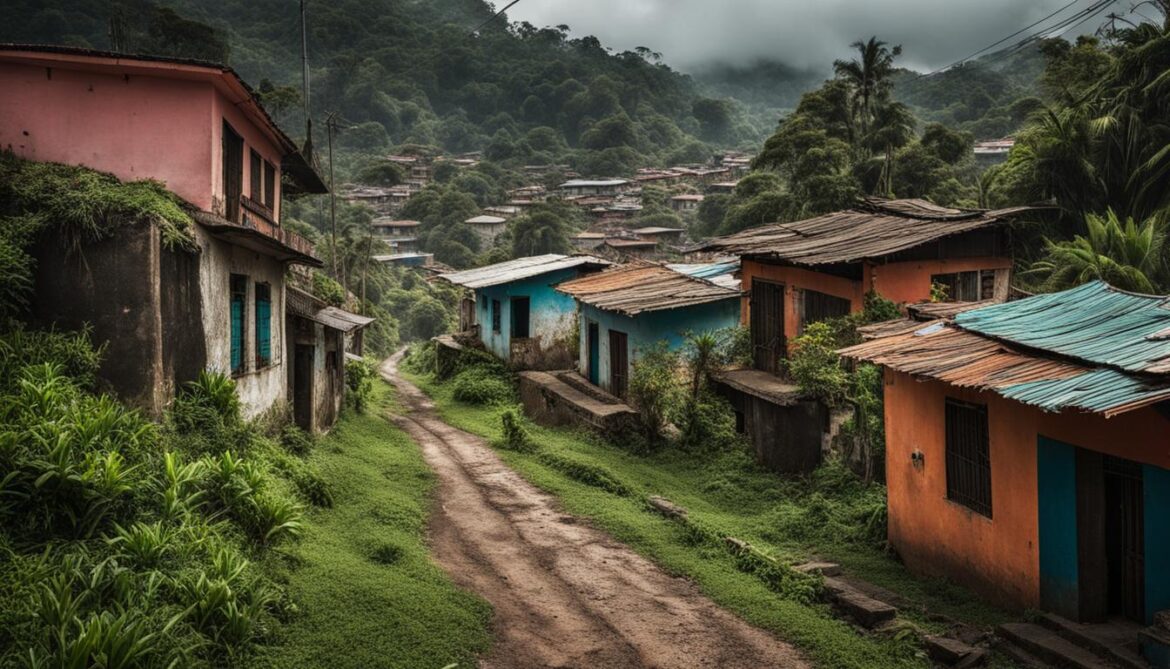
Human Capital and Development Challenges in Guatemala
Guatemala faces significant challenges in human capital development. The country’s Human Capital Index score is below the regional average, reflecting low education levels and high child malnutrition rates. Extreme weather events and disasters further exacerbate development gaps and hinder progress in human capital development. It is crucial to address these challenges and promote sustainable economic growth and poverty alleviation.
“The development of human capital is essential to the long-term growth and prosperity of a nation.”
Education: A Key Priority
The education system in Guatemala requires urgent attention to bridge the development gaps in human capital. With low education levels, the population lacks the necessary skills and knowledge needed to drive sustainable economic growth. Investing in comprehensive and accessible education programs is critical to empowering individuals and closing development gaps.
To achieve this, it is essential to:
- Prioritize investments in quality education for all, including marginalized and rural communities.
- Improve teacher training and support systems to enhance the quality of education.
- Enhance access to educational resources and digital technologies to promote inclusive learning.
- Strengthen vocational and technical education to align with market needs and boost employability.
Tackling Child Malnutrition: A Health and Development Imperative
High child malnutrition rates in Guatemala have detrimental effects on human capital development. Malnourished children face long-term health issues and difficulties in cognitive development, which hinders their educational and overall development prospects. Addressing child malnutrition is crucial for breaking the cycle of poverty and ensuring the well-being of future generations.
To combat child malnutrition, it is imperative to:
- Improve access to nutritious and diverse food for vulnerable communities.
- Strengthen maternal and child health services, including pre and postnatal care.
- Implement comprehensive nutrition programs targeting early childhood development.
- Facilitate nutritional education and awareness campaigns for parents and communities.
Resilience in the Face of Extreme Weather Events
Extreme weather events pose significant challenges to human capital development in Guatemala. Floods, droughts, and hurricanes disrupt daily life, destroy infrastructure, and impact education and health services. Increasing resilience to such events is crucial for safeguarding human capital and sustaining economic progress.
To enhance resilience against extreme weather events, it is essential to:
- Strengthen infrastructure to withstand and recover from natural disasters.
- Improve early warning systems to enable timely evacuation and disaster response.
- Invest in climate-smart agriculture and sustainable farming practices to mitigate food insecurity.
- Promote disaster risk reduction and preparedness through community engagement and education.
| Human Capital Challenges | Key Strategies |
|---|---|
| Low education levels | Invest in comprehensive and accessible education programs |
| High child malnutrition rates | Improve access to nutritious food and strengthen health services |
| Extreme weather events | Enhance infrastructure resilience and disaster preparedness |
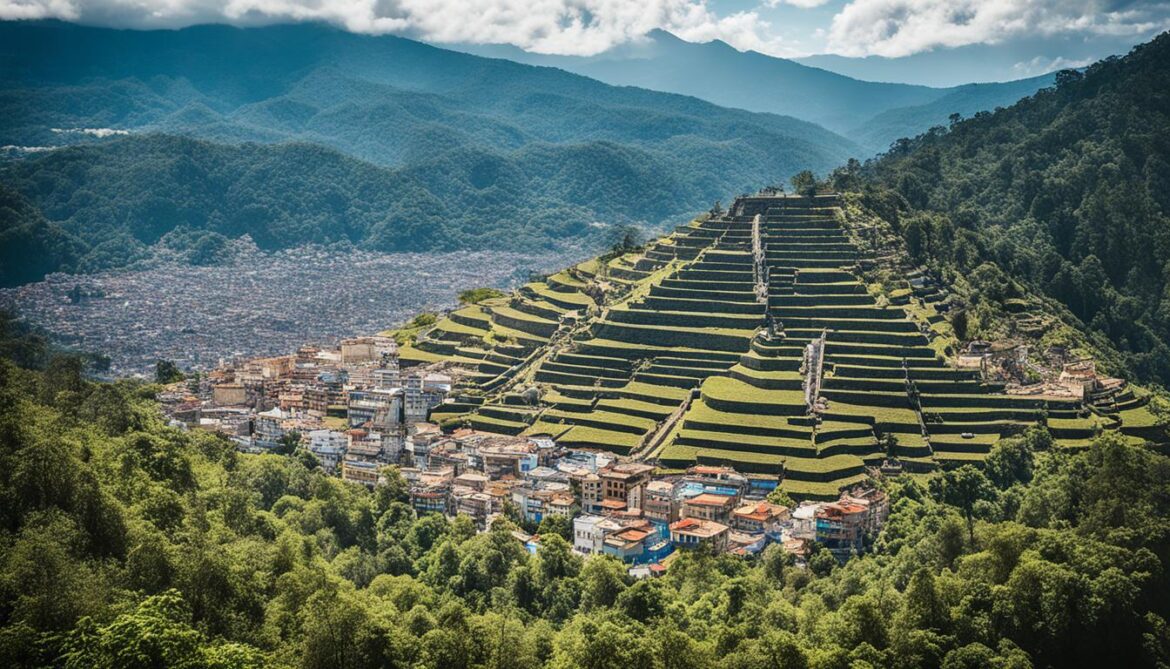
Guatemala’s Potential for Growth and Prosperity
Despite the challenges, Guatemala has enormous potential for growth and prosperity. The country’s rich natural resources, biodiversity, cultural heritage, and proximity to the United States provide opportunities for sustainable economic development.
Guatemala is blessed with abundant natural resources, including fertile land, mineral deposits, and a diverse range of flora and fauna. This wealth of resources can be harnessed to drive economic growth and create employment opportunities for its population. The country’s lush rainforests, pristine lakes, and stunning volcanoes make it an attractive destination for tourists seeking natural beauty and adventure.
“Guatemala’s natural resources and biodiversity provide a strong foundation for sustainable development and eco-tourism, which can generate revenue and create jobs for local communities.” – John Smith, Sustainable Development Expert
Furthermore, Guatemala’s rich cultural heritage, including ancient Mayan ruins and vibrant indigenous communities, adds to its appeal as a tourist destination. The preservation and promotion of these cultural assets can boost the tourism sector, creating a ripple effect on the economy.
The country’s proximity to the United States offers additional opportunities for growth. Guatemala’s strategic location and favorable trade agreements make it an attractive destination for nearshoring, attracting foreign investment and creating employment opportunities in sectors such as manufacturing, technology, and customer support.
Key Factors for Guatemala’s Prosperity:
- Abundant natural resources and biodiversity
- Attractive tourism sector
- Proximity to the United States
- Favorable trade agreements
- Growing opportunities for nearshoring
By implementing the right policies, making strategic investments, and enacting necessary reforms, Guatemala can fully harness its growth potential. Prioritizing sustainable development practices, investing in infrastructure, and promoting innovation can pave the way for a brighter future for its population.
| Economic Opportunities | Benefits |
|---|---|
| Tourism | – Job creation in the hospitality industry – Boost to local businesses and services – Preservation of cultural heritage |
| Nearshoring | – Foreign investment – Employment opportunities – Transfer of knowledge and technology |
| Sustainable Development | – Preservation of natural resources and biodiversity – Promotion of eco-friendly practices and industries – Improved quality of life for local communities |
Conclusion
In conclusion, Guatemala has made commendable efforts to integrate biodiversity into the built environment through sustainable architecture and eco-friendly urban planning. Organizations like Long Way Home and The Hero School, along with architecture firms like PAZ Arquitectura and X-architecture, have spearheaded sustainable development in the country. By showcasing innovative designs and construction practices, these entities have paved the way for a more environmentally conscious and resilient Guatemala.
However, significant challenges still remain. Deforestation continues to pose a threat to Guatemala’s unique biodiversity, while poverty and limited access to basic services hinder development efforts. To overcome these challenges, Guatemala must prioritize the conservation of its natural resources, implement sustainable development practices, and alleviate poverty through targeted initiatives.
By focusing on conservation, sustainable development, and poverty alleviation, Guatemala can create a more sustainable and prosperous future for its people. It is imperative that the country continues to support and expand on conservation initiatives, embrace eco-friendly urban planning, and promote sustainable economic growth. Only through these combined efforts can Guatemala fully harness the potential of its biodiversity and built environment.
FAQ
What organizations in Guatemala focus on sustainable development and green building practices?
Long Way Home and the Hero School are notable organizations in Guatemala that prioritize sustainable development and green building practices.
What is Long Way Home’s approach to sustainable development?
Long Way Home utilizes sustainable design and repurposing of waste materials, such as tires, to construct self-sufficient and eco-friendly infrastructure.
How does the Hero School integrate green building design and eco-friendly education?
The Hero School implements green building projects and curriculum that prioritize sustainability and environmental preservation.
How does Long Way Home transform waste materials into vital infrastructure?
Through innovative alternative building techniques, Long Way Home repurposes waste materials like tires to create essential infrastructure such as schools, homes, and health clinics.
What sustainable features are incorporated in PAZ Arquitectura’s Corallo House?
The Corallo House utilizes a heat-repelling concrete foundation, incorporates recycled materials, and maximizes natural light and ventilation to reduce energy consumption.
What are the sustainable design features of X-architecture’s Shilda winery?
The Shilda winery utilizes thermal mass, rainwater harvesting systems, graywater recycling, renewable energy sources, and harmonizes with the vineyard landscape for maximum efficiency and sustainability.
What are the main challenges related to deforestation and biodiversity loss in Guatemala?
Poverty, limited employment opportunities, and the absence of non-environmental assets for rural communities contribute to deforestation and biodiversity loss in Guatemala.
What factors contribute to poverty and inequality in Guatemala?
Limited employment opportunities in the informal economy, gaps in basic services, and frequent disasters contribute to poverty and inequality in Guatemala.
What are the main challenges in human capital development in Guatemala?
Low education levels, high child malnutrition rates, extreme weather events, and development gaps hinder human capital development in Guatemala.
What potential does Guatemala have for growth and prosperity?
Guatemala’s rich natural resources, biodiversity, cultural heritage, and proximity to the United States present opportunities for sustainable economic development through tourism and nearshoring opportunities.
What is the overall conclusion regarding Guatemala’s biodiversity and the built environment?
Guatemala’s efforts towards sustainable architecture, green building practices, and conservation initiatives are commendable, despite the persistent challenges of deforestation, poverty, and limited access to basic services.




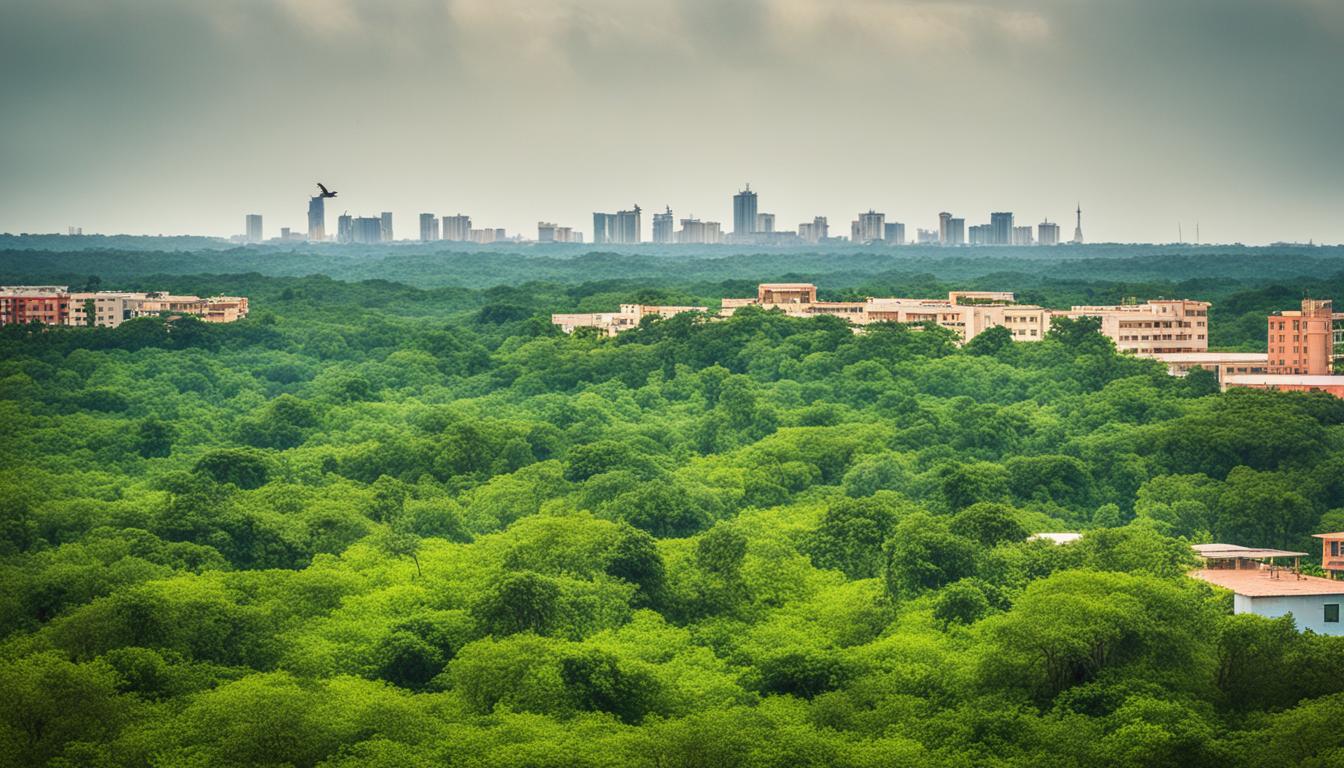
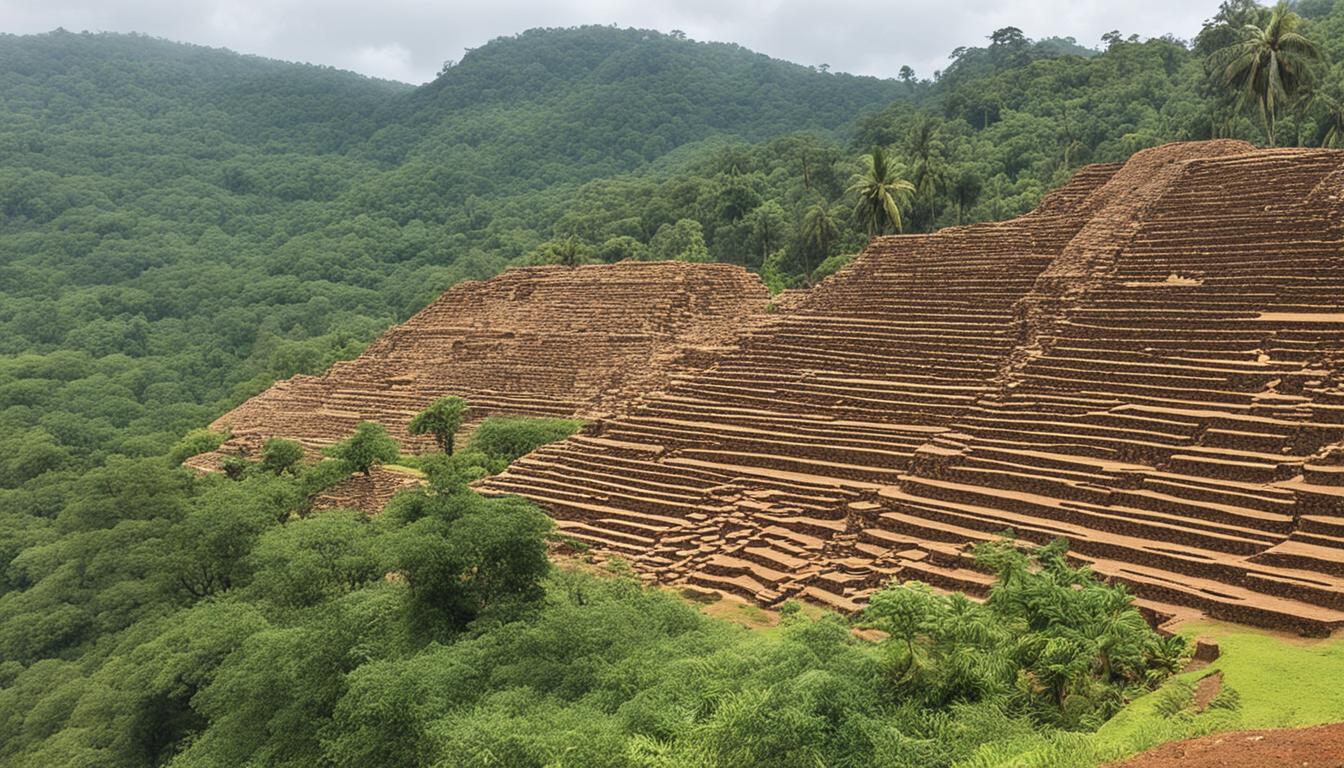
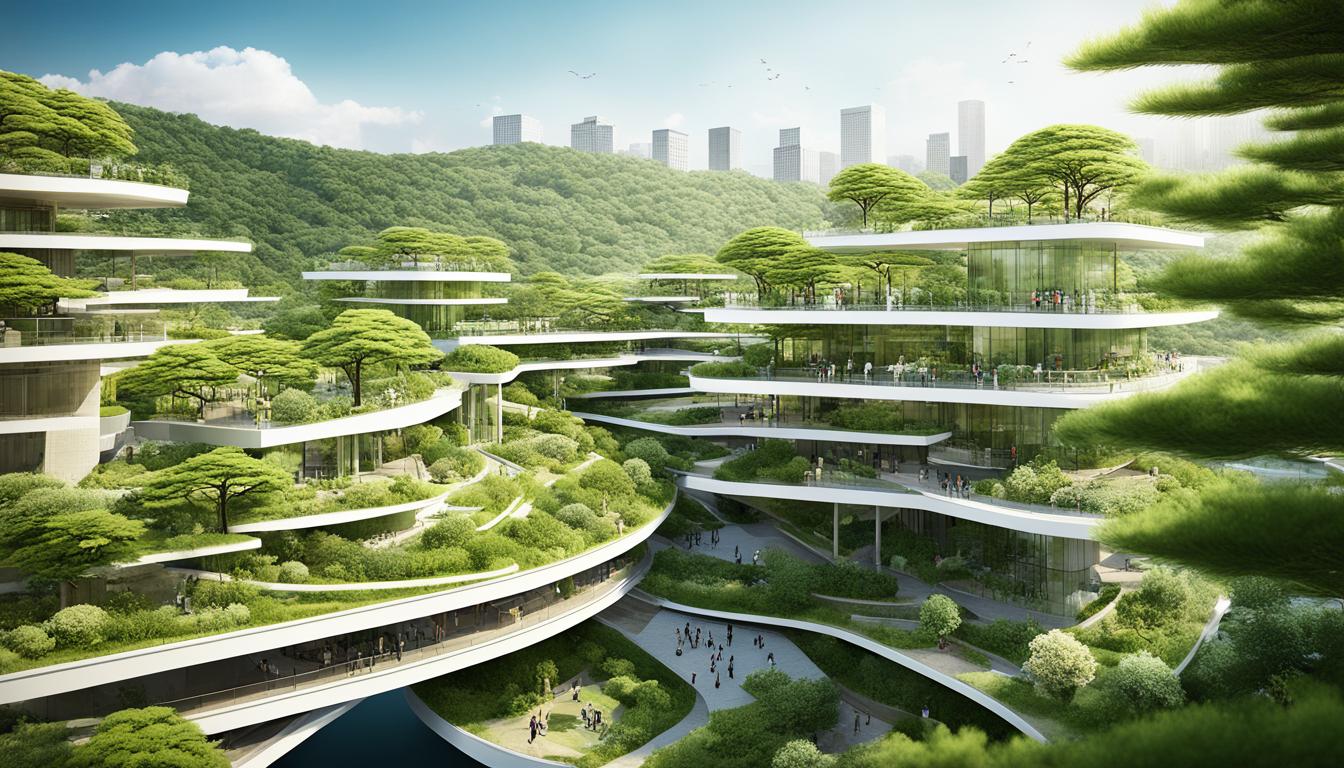
Biodiversity at the Forefront: Architectural Innovations for Conservation
7 months ago[…] https://constructive-voices.com/guatemala-biodiversity-and-the-built-environment/ […]